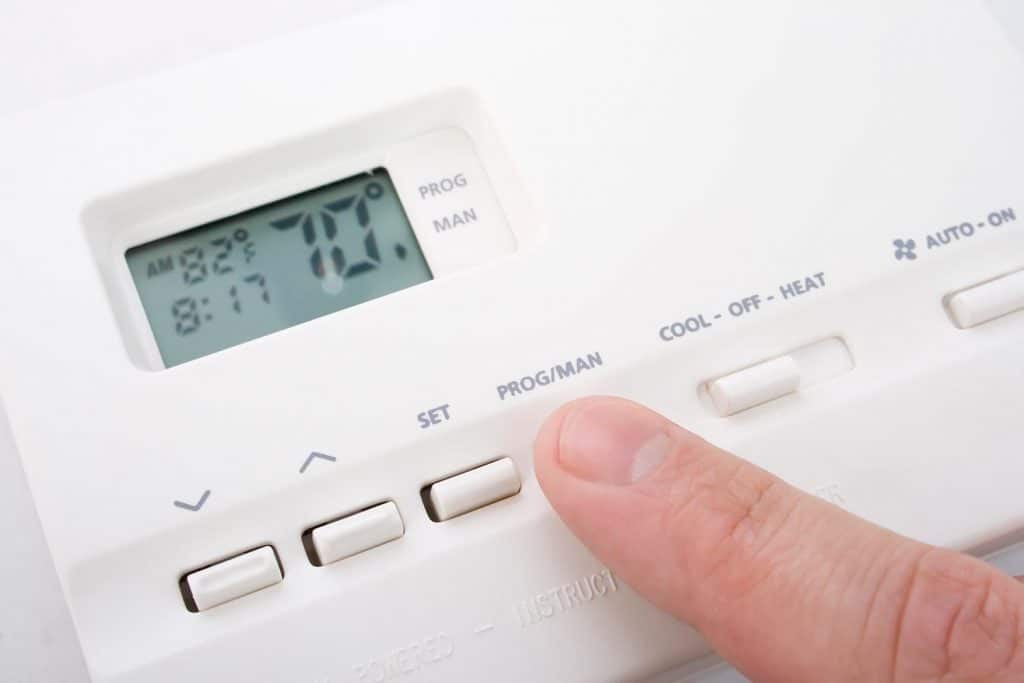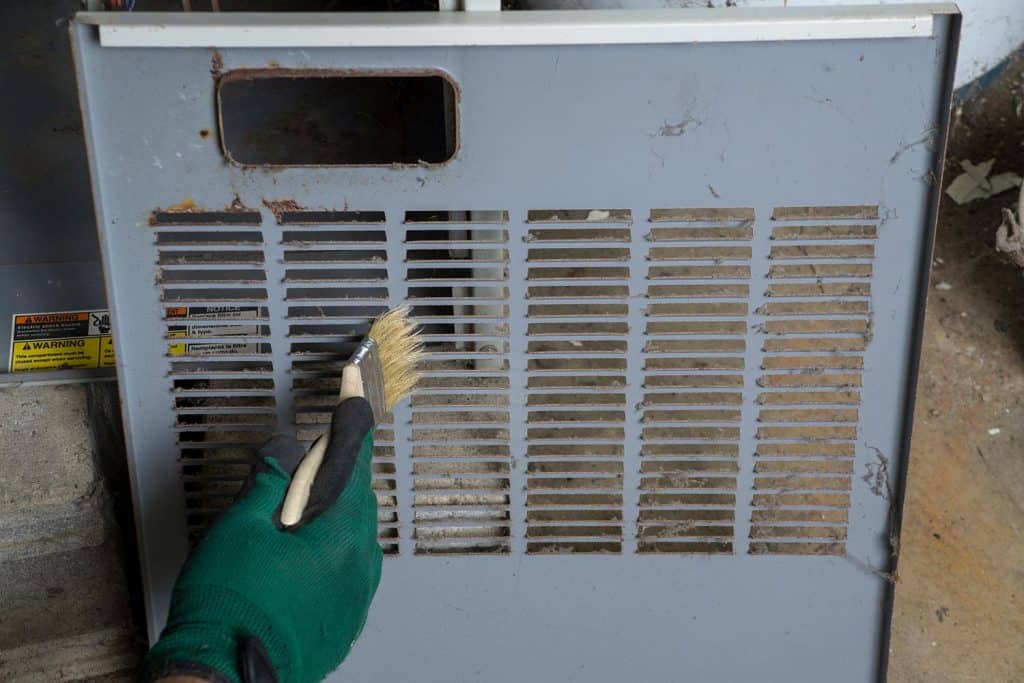Dirty RV furnaces can lead to overheating. Failure to solve the issue by removing the filth and gunk build-up can also become the precursor to serious problems, such as permanent mechanical failure and carbon monoxide poisoning. So how can you ensure the cleanliness of your RV’s furnace? We researched for you and compiled the following guide for your convenience.
Routine cleaning for an RV furnace may require the removal of the heating unit. Once removed, you can proceed to the next step:
- Wipe away loose dust and dirt.
- Vacuum the different parts in and around the furnace, including the ducts and exhaust tubes.
- Clean the heating unit’s metal components.
Keep in mind that the exact process of cleaning an RV’s furnace might be different for each vehicle. It's because the placements of the heating units are often different for every RV. Keep reading to know where to find the furnace in your RV and how to remove it if necessary.
![An air outlet vent of a heater in a camper van, How To Clean An RV Furnace [Including Ducts And Exhaust]](https://vehq.com/wp-content/uploads/2021/11/How-To-Clean-An-RV-Furnace--683x1024.png)
Where Is My RV Furnace Located?
The location of your RV’s furnace often depends on the vehicle’s make and specific model. Here are some examples of certain RVs and the site of their furnaces:
- 2017 Coachmen Freedom Express Ultra Lite: The furnace is underneath the kitchen cabinet area, encased in a dark brown cover.
- 2021 Entegra Odyssey 26D: Find the furnace behind a gated cover underneath the oven.
- 1999 Winnebago Adventurer: The location of the furnace is on the opposite side of the coach. Also, sealant and screws might need removing for these objects can get in the way of accessing the RV heating system.
- 2018 Jayco Eagle: The RV manufacturer mounted the furnace. But it’s hidden in a plywood box under the couch.
Check the vehicle owner’s manual if you’re unsure about the location of your RV’s furnace. Consult the automobile maker if the guide doesn’t specify the location of the heating unit.

At this point, you might also be looking into acquiring a particular RV model. If so, read the following post for a comparison of two known camping vehicle makers: "Jayco Vs. Forest River: Which RV To Choose? (Compared By RV Type)."
How To Remove An RV Furnace?
Before proceeding with this project, take note that the specific steps to take apart a furnace from an RV often depend on the brand and model of the vehicle. For example, some furnaces might be behind sealed coverings.
Remove Sealant & Fasteners
Moreover, different securing materials, such as screws and sealants, may secure the furnace in those encasements. Therefore, the removal of these accessories might come first.
Set-up A Flat Workspace
Also, you need to have a flat surface like a sturdy table to place your furnace upon its removal. Don’t put the furnace on rough terrain since doing so can damage some parts.
Turn OFF The Fuel Line
The final step of the preparation process, and perhaps the most important, is to turn off the gas line attached to the furnace. Leaving the gas turned on while you’re trying to remove the heating system can invite health hazards.
Once you complete the preparations, here’s a guide to let you check what removing a furnace from a Forest River Prime Time Lacrosse 337RKT RV looks like:
Tools You’ll Need
• Phillips screwdriver • Paint scraper
Detailed Removal Steps
- Remove the furnace’s covering. Consult RV’s owner’s manual to know what type of casing you’re currently dealing with.
- Unscrew the exhaust vent with the Phillips screwdriver. Take away the exhaust vent and remove the rest of the screws holding the container in place.
- Next, remove the screws that connect the furnace to its container's outer ring.
- If the RV manufacturer sealed the encasement with silicone, use a paint scraper to remove the sealant carefully. Remove the ring afterward.
- Loosen the gas line and push it into the hole at the top of the heater.
- Take away the furnace’s strap before pulling it out.
- Pull the furnace’s container a few inches out. Then, return to the inside of the RV and disconnect the ductwork and electrical from the heating unit.
- Move back outside and remove the furnace and its container out of the RV. Place the heating system on the table to proceed with other projects, such as cleaning it.
You can also watch the video below to see the removal process in action:
How Do You Clean Your RV Furnace?

Some RV models require you to remove the furnace to clean it properly. But take note that you shouldn’t attempt to remove a sealed furnace, particularly one with a gasket seal. Attempting to apply an unnecessary force to the gasket may result in a carbon monoxide leak.
Immediately refer to the RV manufacturer or the vehicle’s manual to learn the best way to deal with this concern. But if you can remove the RV furnace safely, you should know that regular cleaning for the vehicle’s heating system usually doesn’t need special equipment.
Here’s how to do this cleaning job:
- Use a clean microfiber cloth to remove loose dust and dirt in and around the furnace.
- Vacuum the heating unit to suck up more filth and gunk that you weren’t able to pick up using the cloth. Don’t forget to use the vacuum cleaner on the exhaust and ductwork.
- Finally, use a damp cloth or rag to wipe the metal components.
While you’re cleaning the RV furnace, you may also want to continue the routine maintenance to check the heating system for potential problems. Some of the areas you may inspect are:
- Fuel supply
- Intake or exhaust tube
- Battery
Pay attention to any damages or faults you may find in those areas. For example, if you notice that your battery is malfunctioning, continue your troubleshooting efforts to that specific part. You can also read this post to help you solve certain RV battery issues: "RV Battery Not Working: What To Do?"
Is There A Filter On An RV Furnace?
Not every RV has a built-in filter for their furnaces. It can even be quite difficult to acquire a camping vehicle with a filter included with the fitted heating system.
But you can purchase an aftermarket furnace filter, which isn’t difficult to find. If you can procure a third-party filtering unit, watch the video below to help you with the installation:
Check out this motorhome furnace filter on Amazon.
How Do I Keep Mice Out Of My RV Furnace Ducts?
You have different options to keep mice away from accessing your RV furnace’s ductwork. Some of these pest deterring solutions are:
Install Vent Covers
Some RV furnaces may have their ducts connected to roof vents. If so, you need to cover these openings with casings to prevent mice from entering your RV. Make sure to check the compatibility of the vent cover to avoid extra expenses.
Watch the video below to if you need help with the vent cover installation:
Check out this RV vent cover on Amazon.
Keep the Area Clean
Trash and comfortable warmth is a combination that’s fit to become a mice nest. Avoid leaving trash near your RV furnace’s ducts by making sure you throw your garbage in appropriate places.
Diffuse Peppermint Oil
The strong smell of peppermint oil can hurt a mouse’s sensitive nose. The scent often feels like an annoying, burning sensation when sensed by mice. Therefore, spreading this fragrance in your RV with the help of an essential oil diffuser can help deter the pests away from your vehicle.
Check out this product on Amazon.
Adopt a Cat
Take note that having a cat isn’t a surefire way to keep mice away from your RV’s ductwork. It’s because you need to pay attention to the kitty’s breed as some cats don’t exercise their natural hunting instincts as others. If you’re looking to adopt a cat to help you hunt and keep mice away from your camping vehicle, some breed options are:
- Japanese Bobtail
- Manx
- Persian
- Siamese
- American Shorthair
How Long Do RV Furnaces Last?
Rig owners should have different expectations with their RV’s furnaces depending on the type of their heating systems. Take note that these heating units are often in one of two product classes: electric or propane.
Here’s a quick guide on how to know a rough estimate of your RV furnace’s running time:
- Propane: It takes about 3 hours of continuous use if the furnace is connected to a gallon of propane.
- Electric: The furnace can continuously run for about 12 hours, assuming that the RV battery isn't supplying power to other electronics.
Final Words
Regular cleaning and maintenance for an RV furnace don't often require special equipment. You might only need a few clean cloths and a vacuum cleaner to complete the job. Remember to refer to your owner’s manual or ask the vehicle’s manufacturer if you run into issues while caring for the heating unit.



